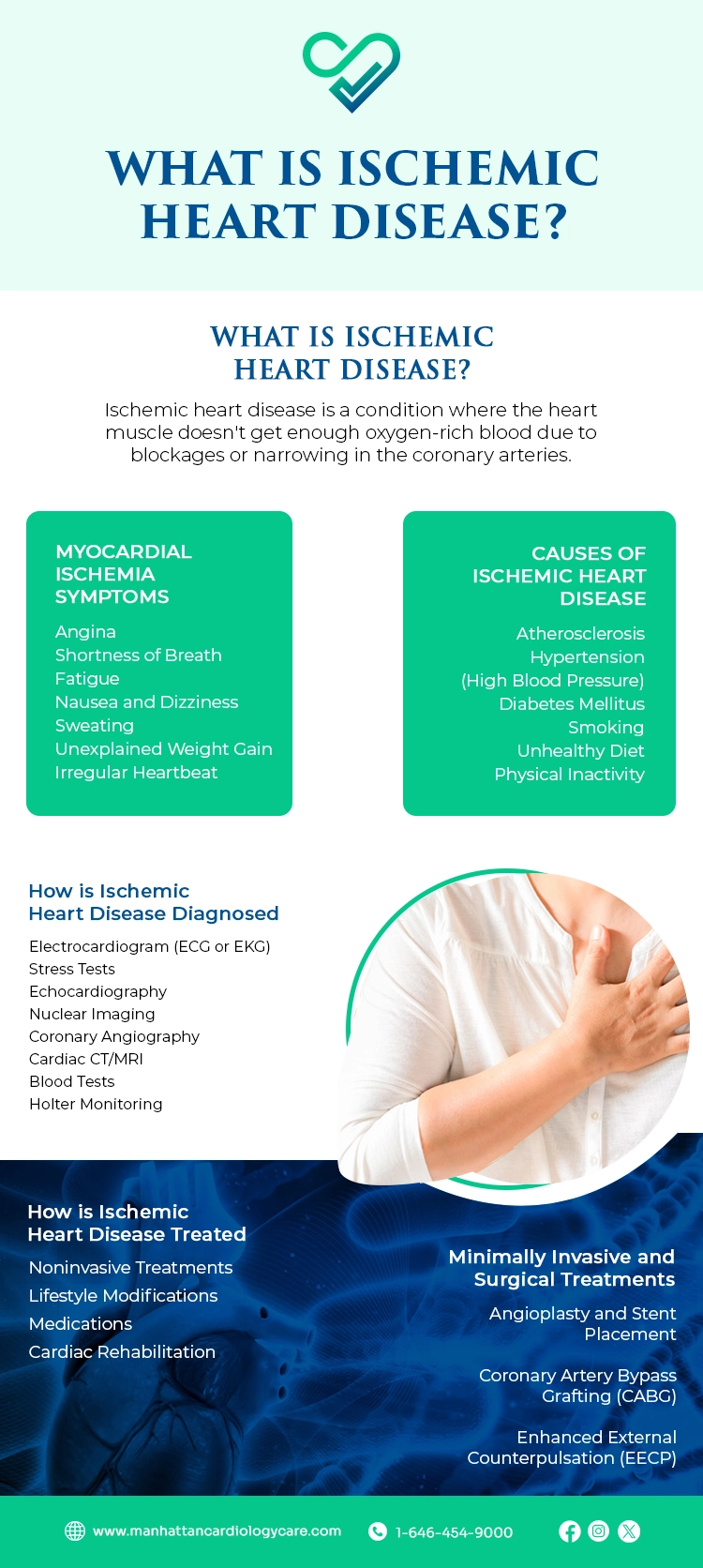At the core of our discussion lies Ischemic Heart Disease (IHD), a condition that is characterized by insufficient blood supply to the heart muscle. This insufficiency occurs when the coronary arteries, responsible for delivering oxygen and nutrients to the heart, become narrowed or blocked. As the heart muscle is deprived of essential resources, it leads to a cascade of potentially life-threatening events.
Table of contents
Myocardial Ischemia Symptoms
Recognizing the myocardial ischemia symptoms is necessary for early intervention and improved outcomes.
Here’s a list of all the possible myocardial ischemia symptoms:
- Angina: The main myocardial ischemia symptom is angina, which presents as chest discomfort or tightness. Described as squeezing or pressure, it can radiate to the arms, neck, jaw, shoulder, or back. Occurs during activity or stress, subsiding with rest.
- Shortness of Breath: Ischemic heart disease compromises the heart’s effective blood pumping, leading to breathlessness during exertion or at rest, indicating inadequate oxygen supply to the body.
- Fatigue: Unexplained fatigue, especially during routine activities, is a subtle yet significant myocardial ischemia symptom. The heart’s struggle to meet the body’s oxygen demand prompts lingering weariness, impacting daily life.
- Nausea and Dizziness: Ischemic heart disease may induce nausea and dizziness due to compromised blood flow affecting the heart and circulation to the brain, signaling a potential cardiac issue.
- Sweating: Profuse sweating, often with cold and clammy skin, is a response to heart stress. Manifests during exertion or stress, indicating potential heart issues.
- Unexplained Weight Gain: IHD leads to fluid retention, causing unexplained weight gain. Resulting from the heart’s compromised pumping ability, it particularly affects the legs, ankles, and abdomen.
- Irregular Heartbeat: Arrhythmias, irregular heartbeats, signal potential IHD issues. Palpitations, fluttering sensations, or a feeling of the heart “skipping a beat” may indicate an underlying electrical system problem.
Causes of Ischemic Heart disease
Understanding these causes is crucial for adopting preventive measures and cultivating heart-healthy habits.
- Atherosclerosis: Cholesterol, fat, and substances form plaques in coronary arteries, narrowing them and setting the stage for heart complications.
- Hypertension (High Blood Pressure): Elevated blood pressure stresses arterial walls, contributing to atherosclerosis and increasing the heart’s workload, leading to Ischemic Heart Disease.
- Diabetes Mellitus: Impairs blood sugar regulation and accelerates atherosclerosis, heightening the risk of coronary artery disease and Ischemic Heart Disease.
- Smoking: Toxic substances in cigarette smoke accelerate atherosclerosis and promote blood clot formation, compromising blood flow and increasing Ischemic Heart Disease risk.
- Unhealthy Diet: Diets high in saturated fats, cholesterol, and sodium contribute to atherosclerosis, elevating cholesterol levels and fueling Ischemic Heart Disease progression.
- Physical Inactivity: A sedentary lifestyle contributes to obesity, exacerbating cardiovascular risk factors, weakening the heart, and fostering conditions like hypertension and diabetes, precursors to Ischemic Heart Disease.
How is Ischemic Heart Disease Diagnosed?
The wide range of diagnostic methods employed in the quest for identifying Ischemic Heart Disease include:
- Electrocardiogram (ECG or EKG): Electrocardiogram records the electrical activity of the heart. Abnormalities in the ECG, such as ST-segment changes, can be indicative of ischemia or damage to the heart muscle.
- Stress Tests: Stress tests assess the heart’s response to exertion. Abnormalities observed during stress, such as changes in heart rate or rhythm, can reveal underlying ischemic conditions.
- Echocardiography: Echocardiography utilizes ultrasound waves to create detailed images of the heart’s structure and function. This non-invasive test helps assess the heart’s pumping capacity, identify abnormalities in the heart valves, and detect areas of reduced blood flow.
- Nuclear Imaging: Nuclear imaging techniques, such as SPECT or PET scans, involve injecting a small amount of radioactive material into the bloodstream. These scans highlight areas of the heart with reduced blood flow, aiding in the identification of ischemic regions and the extent of damage.
- Coronary Angiography: In this invasive procedure, a contrast dye is injected into the coronary arteries, allowing X-ray imaging to capture a detailed map of the heart’s blood vessels. Coronary angiography reveals the presence and location of blockages or narrowed arteries.
- Cardiac CT/MRI: Cardiac CT or MRI provide detailed three-dimensional views of the heart – these techniques offer unparalleled insights into the heart’s structure, blood flow, and any abnormalities.
- Blood Tests: Blood tests play a vital role in assessing cardiac health. Elevated levels of cardiac biomarkers, such as troponins or creatine kinase-MB (CK-MB), may indicate heart muscle damage.
- Holter Monitoring: Holter monitor records the heart’s electrical activity over an extended period. This portable device captures irregularities that may not be evident during a standard ECG, diagnosing arrhythmias or silent ischemia.
How is Ischemic Heart Disease Treated?
The diverse treatment options for Ischemic Heart Disease are inclusive of:
Noninvasive Treatments
- Lifestyle Modifications: Adopt heart-healthy habits with a low-saturated fat diet, regular exercise, weight management, and quitting smoking to reduce risk factors and enhance overall heart health.
- Medications: Essential in Ischemic Heart Disease management, medications like aspirin, statins, beta-blockers, and ACE inhibitors are tailored to address specific aspects, promoting heart function and reducing complications.
- Cardiac Rehabilitation: Structured programs incorporating exercise, nutritional counseling, and emotional support empower Ischemic Heart Disease patients to regain strength and overall cardiovascular health.
Minimally Invasive and Surgical Treatments
- Angioplasty and Stent Placement: Swift relief through inflating a balloon in a narrowed artery, coupled with a mesh tube (stent) to keep it open, preventing future blockages. Commonly used in Ischemic Heart Disease management.
- Coronary Artery Bypass Grafting (CABG): Surgical redirection of blood flow around blocked arteries using grafts from other body parts. Highly effective, especially for complex coronary issues.
- Enhanced External Counterpulsation (EECP): Noninvasive therapy involving external compression of lower extremities to enhance blood flow to the heart. An option for those unsuitable for surgery or angioplasty, reducing myocardial ischemia symptoms and improving overall cardiovascular function.
Frequently Asked Questions
What is the difference between heart disease and ischaemic heart disease?
Heart disease is a broad term encompassing various heart conditions. Ischemic heart disease, a specific type, involves reduced blood flow to the heart muscle due to narrowed or blocked arteries.
Can you live a long life with ischemic heart disease?
Yes, with proper management and lifestyle changes, it’s possible to live a long, healthy life with ischemic heart disease. Regular medical check-ups and adherence to prescribed treatments are crucial.
What is the first line treatment for ischemia?
Lifestyle modifications are the initial approach. This includes a heart-healthy diet, regular exercise, weight management, and quitting smoking. Medications, such as antiplatelets and statins, are often prescribed as well
– Disclaimer –
This blog is for informational & educational purposes only, and does not intend to substitute any professional medical advice or consultation. For any health related concerns, please consult with your physician, or call 911.


